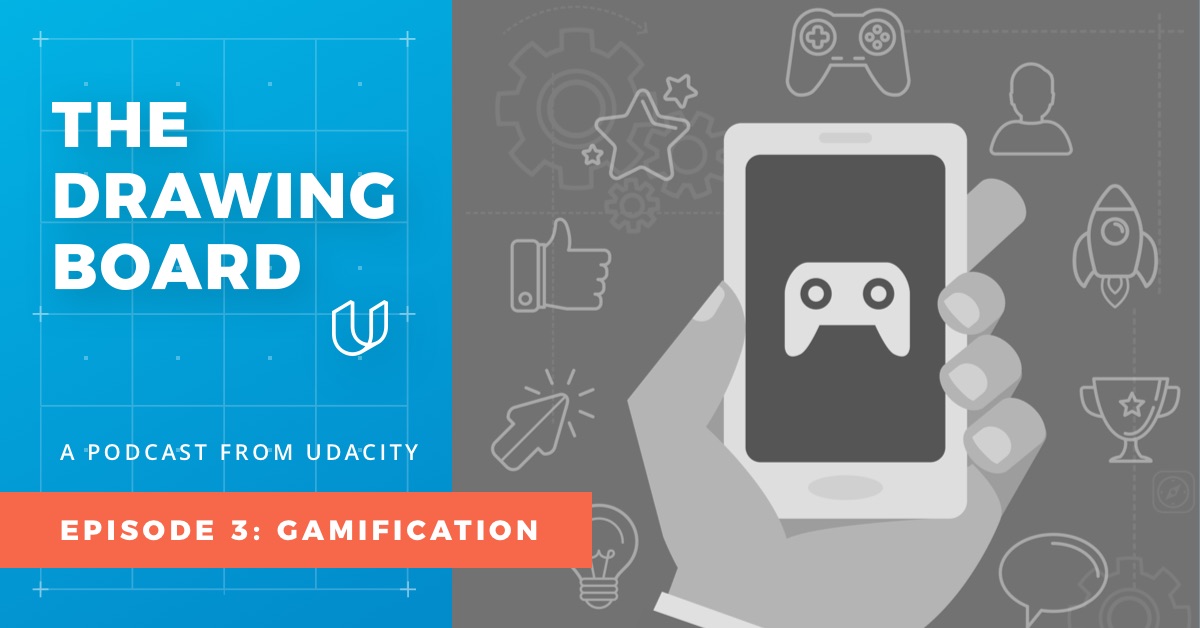
Games are fun. It’s no coincidence they’re most often associated with the verb “to play.” This is why gamification is such a big deal these days. It’s also why gamification is our topic for the 3rd episode of The Drawing Board, our new Udacity podcast!
If you’re not quite sure what gamification is, you need only turn to Mary Poppins to understand:
In every job that must be done
There is an element of fun
You find the fun and snap!
The job’s a game
And every task you undertake
Becomes a piece of cake
A lark! A spree! It’s very clear to see that
A spoonful of sugar helps the medicine go down
The medicine go down, the medicine go down
Just a spoonful of sugar helps the medicine go down
In a most delightful way
Put another way, the idea behind gamification is simple—borrow what’s great about the experience of playing video games, and use it to make other things more enjoyable! Competition, scoring, prizes—these are just some of the ingredients of what gamification can bring to just about any user experience, if you know how to do it right.
Our guests for Episode 3: Gamification are:
- Kenneth Strickland, Lead Game Designer on the new South Park video game by Ubisoft
- Gina Gotthilf, VP of Marketing and Growth at Duolingo
- Aaron Forth, Chief Product Officer at Strava
- Amelia Lin, Udacity Project Manager, and a veteran of the game industry
Each of these wonderful individuals brings great insights to the episode, and you are encouraged to listen to each segment in its entirety.
“Gamification poured into every lesson”
To give you an example of the excellence on offer, we’d like to share some of what Gina Gotthilf has to say—she essentially delivers a Gamification 101 clinic during her segment. Her company, Duolingo, helps teach people new languages via their website and their app. Here’s Gina on how gamification has played a role in the phenomenal success of their service:
“The thing about learning languages is that it takes a really long time. You can’t just say, ‘Okay, this weekend I’m going to learn French.’ You have to study for a year or two years. Depending on the language, it could be more than three years. I studied Chinese for three years, and I don’t consider myself fluent at all. So the experience of learning a language has to be engaging, especially if you’re not in a classroom scenario where you actually have to pay to go to the school. If it’s just an app, or if it’s just something digital that you opt into, it has to be extremely compelling to compete with every other thing that’s trying to compete for your attention when you have free time.”
Getting paid to play games
If you’re starting to see where this is all headed, it turns out you’re actually right! Implementing successful gamification strategies actually DOES require sitting around and getting paid to play games! Here is Gina again:
“What we do is we actually play a bunch of games at Duolingo, and then we have meetings and say, ‘Okay, what was interesting about this game? Did you notice how there’s this character, and this happens? Or did you notice this notification and the way that it interacts with the user?’ Then we think about ways that we could use that in the context of learning a language and try to apply it, and try to make Duolingo more bite-sized, more fun, more addictive so that people will willingly come back to it when they’re waiting for the bus instead of playing Tetris.”
Gamification and Retention
Don’t allow yourself to make the assumption that Duolingo’s version of gamification simply comes down to adding a bunch of goofy bells and whistles to their app in order to make it more fun. Their mission is a serious one, and they take it seriously:
“If we made Duolingo extremely easy and funny and fun, I’m sure we could improve retention. I’m sure we could improve monetization too. But at the end of the day, we made this so that people are learning languages. That’s the goal, and we actually have a learning metric, and we have a learning team, so we take this seriously. So the value of the retention component and the gaming component are only valuable inasmuch as they’re helping people learn.”
The Drawing Board, Episode 3: Gamification
We’re so grateful to have such amazing guests join us for The Drawing Board, and we hope you’ll dive into Episode 3 just as soon as you can, so you can hear more from Gina, as well as from Kenneth, Aaron, and Amelia.
Whether you’re a working professional looking for inspiration and guidance on how to successfully implement gamification strategies at your organization, or you’re just looking for a spoonful of sugar to make your medicine go down, Episode 3 of The Drawing Board has got some great stories to tell you!



